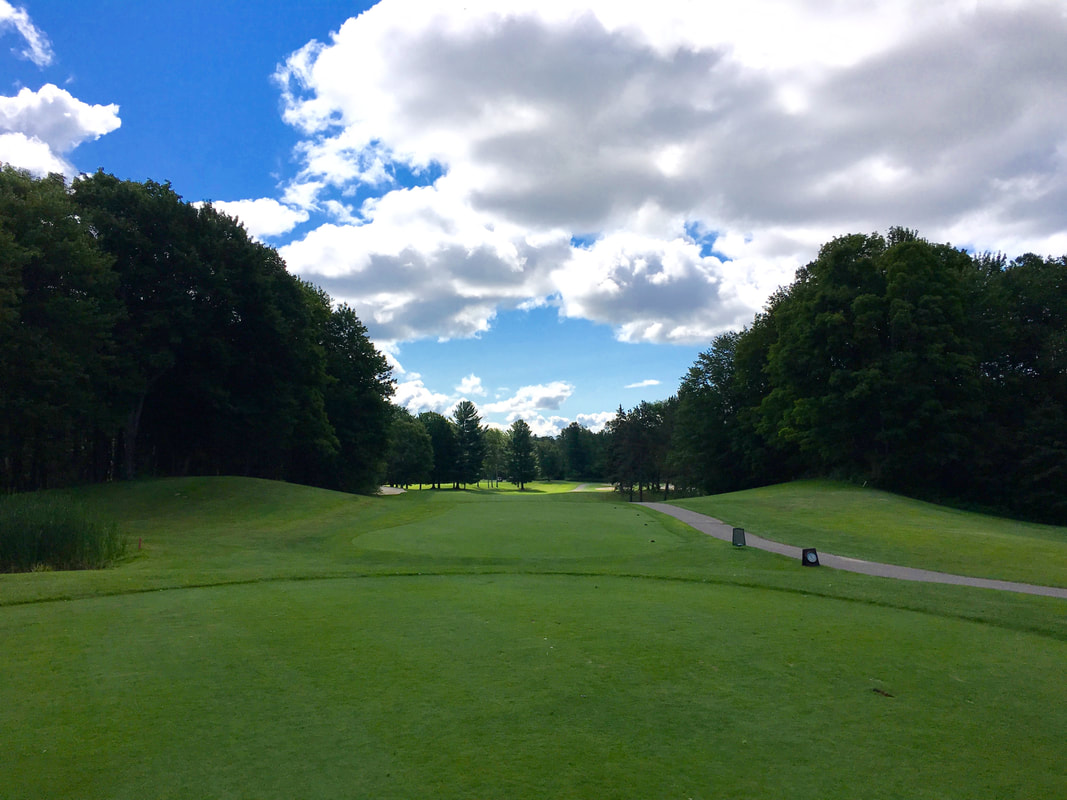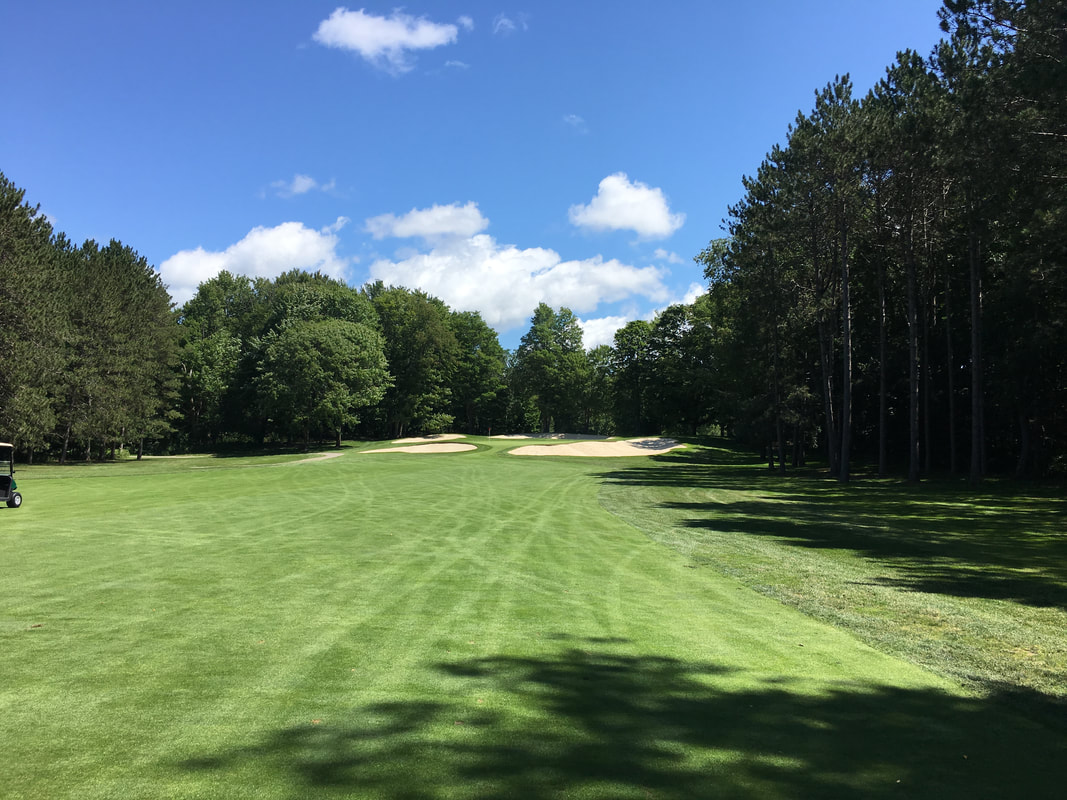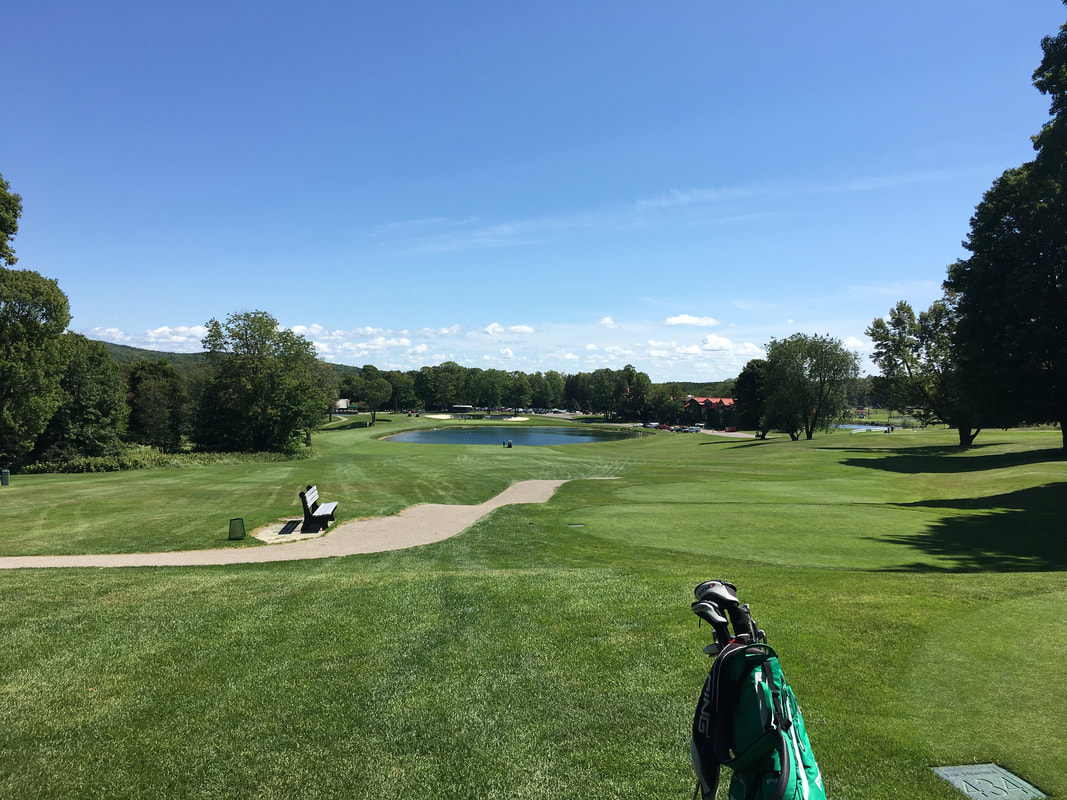The Heather was the first course at Boyne Highlands and was designed by Robert Trent Jones Sr., right at the height of his career in 1966. Not surprisingly, it exemplifies the most well-known characteristics of his work (for better or worse). Most holes are playable, but it’s pretty hard to make a par—so hard par, easy bogey. I’d played the Heather once before my summer 2020 visit, in early May about 10 years before in cold, wet spring weather. So I wasn’t too impressed by the course. But then a year or two after that, it started showing up in Golf Digest’s top 25 courses in the state…and then showed up a few times on their top 100 public courses! I was baffled by this, as I thought that time and taste had since long passed it by. But when I was headed up to Greywalls with my travel golf buddy Bob—who hadn’t played it before and wanted to check a box (his goal seems to be to play ever course in Michigan, no matter how terrible)—it gave me an opportunity to see if my original assessment of the course had been off.
I’m pleased to say that it was off by a bit—this is a better course than I had remembered. But more notably, it’s a much more difficult course than I had remembered. And I think that that’s part of the reason that I liked it more; I’ve become a better golfer in the last 10 years and this is the type of course that a good player is going to like. Like I said, it exemplifies Trent Jones Sr.’s work; most of the holes are a ‘hard par, easy bogey.’ If you’re a good player who hits the ball fairly straight and can put an iron into the air, it’s a very good test of golf. But as Bob can attest, it’s very hard for the higher handicap. There are ponds in front of several of the greens and bunkers in front of the ones that don’t have ponds. It’s too hard for the average resort golfer, but everything is front of you and there’s usually room to avoid the trouble—with a few notable exceptions.
The first three holes are fairly similar; medium length par 4s that dogleg right, with the primary driving hazard on the right. They’re also all essentially without fairway bunkers as the one fairway bunker, left of one, has become mostly obscured by tree growth. Each also has a few green side bunkers and a green that angles slightly from front-left to back-right. Nothing too special but hey, this is Trent Jones Sr. in the peak of his career when everyone who hired him probably just told him to keep doing what he was doing.
I’m pleased to say that it was off by a bit—this is a better course than I had remembered. But more notably, it’s a much more difficult course than I had remembered. And I think that that’s part of the reason that I liked it more; I’ve become a better golfer in the last 10 years and this is the type of course that a good player is going to like. Like I said, it exemplifies Trent Jones Sr.’s work; most of the holes are a ‘hard par, easy bogey.’ If you’re a good player who hits the ball fairly straight and can put an iron into the air, it’s a very good test of golf. But as Bob can attest, it’s very hard for the higher handicap. There are ponds in front of several of the greens and bunkers in front of the ones that don’t have ponds. It’s too hard for the average resort golfer, but everything is front of you and there’s usually room to avoid the trouble—with a few notable exceptions.
The first three holes are fairly similar; medium length par 4s that dogleg right, with the primary driving hazard on the right. They’re also all essentially without fairway bunkers as the one fairway bunker, left of one, has become mostly obscured by tree growth. Each also has a few green side bunkers and a green that angles slightly from front-left to back-right. Nothing too special but hey, this is Trent Jones Sr. in the peak of his career when everyone who hired him probably just told him to keep doing what he was doing.
Speaking of similarity, the medium long par 3 fourth is the first of three similar par 3s, all full carries over ponds. This one has a large and undulating green so after three only moderately hard holes, this one gives you a real taste of what’s to come.
The par 5 fifth is one of the hardest par 5s in the state of Michigan. The fairway is wide enough, but there are wetlands left and forest (plus cart path) right. You really need to drive the ball as far as you can and up the left side to avoid having to play this hole very defensively because a pond starts about 250 yards out from the green on the left side and the hole doglegs continuously left around it. If you want to lay-up within 100 yards of the green, you have to carry the pond to get there. This is a very intimidating shot because it looks like if you hit it too far or push it on this line, it’ll run into wetlands through the fairway. They may or may not be true; I just hit a pitching wedge out to the right and then another onto the green. If you’re a good player, it’s always important to remember that even if you play very conservatively to a tough par 5 with your lay-up, the next one won’t be too long (unless you screwed up your drive…).
After another all carry par 3 over a pond, we have another medium length par 4, this time a dogleg left. The green is on about a 45 degree angle front left to back right so here, it’s important to hug the inside of the dogleg—moreso than on the first few holes because the green is quite shallow from the right. The eighth is also a dogleg left, but it’s a long par 4 with fairway bunkers right. The premium here is more on distance rather than being in one side of the fairway or the other because the green is open in front, with the bunkers to the sides.
The ninth is another difficult dogleg left par 5 with a pond on the left. Unless you hit a very good drive, this pond makes the lay-up very tough because you’ll have to thread it between the pond and trees on the right. If you hit a good drive, you can easily carry the pond to a generous lay-up area for the last 125 yards of the hole. The green is elevated with three bunkers in front.
The back nine is very difficult, but results in fewer lost balls as it replaces ponds with bunkers. The medium long gently right doglegging par 4 tenth has five bunkers just short and around the green. You’ll need to drive up the left side to have a good angle in. The short par 5 eleventh has two staggered fairway bunkers but unless you’re name is Bryson DeChambeau or maybe Rory McIlroy, you won’t be able to reach the one on the left so you just need to avoid the one on the right. If you’re laying up, there’s not much to think about. But as we’ll see, the green is typical for this nine, completely surrounded by four huge bunkers.
After the least interesting of the three pond par 3s, we come to two very difficult medium long par 4s. The thirteenth doglegs left and has no fairway bunkers, but the green is elevated and completely surrounded by four large bunkers. The fourteenth green is also elevated and again, completely surrounded by four large fairway bunkers. The difference here is that this drive is straight, but there’s a big fairway bunker on the right and a ridge bisecting the fairway, meaning that you’ll have to hit a good drive just to get a view of the green that you probably won’t hit (maybe a blind shot in is just as well…).
Like the eleventh, the fifteenth is a fairly short par 5 and will be reachable off a good drive. It’s better to be in the left side of the fairway of this slight dogleg left because this time, Trent Jones left a generous 20 foot wide opening between the two front green side bunkers on the left side. The sixteenth is the first par 3 that isn’t over a pond and is a very nice hole, perched into a left-to-right slope with a big green side bunker short right and two left, setting up nicely for a fade.
The seventeenth concludes the most merciful three hole stretch since the first three. It’s a nice medium short length par 4, doglegging right up a hill. Hopefully you’ve played them well and built up a reserve of good humor, which you’ll need for the eighteenth. This is one of the most ridiculous holes in the state—a long par 4 where the fairway runs out about 170 yards short of the green, leaving about 160 yards of pure carry over a pond. But don’t worry, Trent Jones left a 12 yard wide strip of fairway along the pond to the left…and your ball runs down a hill into the pump house if you miss it left (apparently the owner wanted it to be all carry and Trent Jones had to convince him to let him leave even this narrow strip). Unless you manage to drive your ball into the little corner between the pond and the beginning of lay-up strip, you may end up throwing as many clubs into the pond as you hit balls (I wonder which water hazard in the state of Michigan gets the most clubs per player?).
I can’t imagine how difficult this course must have been in the late 60s with the equipment that they’ve had. Maybe it didn’t play as long as its current 7,150 from the back tees (I sure hope not), but unless you were a really long hitter, most of the greens would have required very high, soft shots to hold. They still do and unless you’re a really long hitter, it’s going to be a major struggle. I’m a kind-of short-hitting 2 handicap and it was a real bitch from the mixed back tees (maybe 6,800). A lot of these resort courses are listing mixed back tees on the scorecard, where you move up on most of the toughest holes (I like this and make them up for myself on courses that don't have them). Unless you’re better than a scratch, that’s as far back as you should go here.
Despite the difficulty, I liked the Heather. Other than the last hole, it’s an honest challenge. And, unlike every other Boyne course that I’ve played, it’s a good walk. The green-to-tee distances are all short and the terrain is very modest for a course in this part of the state. It'd be a fantastic tournament course, I think even for the PGA Tour (I think it's harder than Innisbrook's Copperhead course, which is always one of the harder ones on tour).
So even though it’s nowhere near being a great course and doesn’t really have any business being on a list of the top 25 courses in the state or certainly the top 100 public courses in the country, it’s worth playing if you’re in the area—provided that you bring your 3 handicap friends and not your 25 handicap ones. Unless they’re a scratch with a ball retriever.
Despite the difficulty, I liked the Heather. Other than the last hole, it’s an honest challenge. And, unlike every other Boyne course that I’ve played, it’s a good walk. The green-to-tee distances are all short and the terrain is very modest for a course in this part of the state. It'd be a fantastic tournament course, I think even for the PGA Tour (I think it's harder than Innisbrook's Copperhead course, which is always one of the harder ones on tour).
So even though it’s nowhere near being a great course and doesn’t really have any business being on a list of the top 25 courses in the state or certainly the top 100 public courses in the country, it’s worth playing if you’re in the area—provided that you bring your 3 handicap friends and not your 25 handicap ones. Unless they’re a scratch with a ball retriever.

















 RSS Feed
RSS Feed